Table of Contents
- mHealth Apps Historical Statistics
- What are mHealth apps?
- How Widely Used Are mHealth Apps?
- Global mHealth Market Statistics
- Who Downloads and Uses Health Apps?
- Who Uses Health Apps and Why?
- Top 5 mHealth Apps Statistics
- Count of mHealth Apps in the Google Play Store
- Leading iPhone health and fitness apps in Canada
- mHealth Market Revenue of Latin America Statistics
- COVID-19 and the mHealth apps Revolution Statistics
- China’s mHealth Apps: Pre and Post-COVID-19 Usage Statistics
- mHealth app Statistics: Challenges Unveiled
- Recent Developments
- Conclusion
- FAQs
mHealth Apps Statistics – highlight the growth of technology in the healthcare industry and how it’s making services more accessible and convenient for individuals.
Apps have become an important part of our daily life. Smartphones, laptops, or other technological devices are not without apps. In healthcare, apps have become a standard solution to several problems and issues in the healthcare industry.
Health apps can be accessed anytime and anywhere, making it easy for people to monitor their health and stay at peak in their fitness goals.
Health apps can be an important tool for individuals looking to improve their health and well-being. To achieve your health goals and just show you how health apps change your fitness journey we have made some trending stats for you.
Before that let’s take a look at what mHealth apps are. what is their history? and how popular are the mHealth apps?
mHealth Apps Historical Statistics
The concept of mHealth apps is relatively new, and developments in mHealth apps are rapidly increasing in the past few decades. In the 2000s researchers and medical professionals began experimenting with mobile phones to improve healthcare services in low-source settings.
SMS messaging was the first tool used to provide health information and reminders to patients. In 2023, the World Health Organization (WHO) established the Global Observatory for eHealth which was aimed to track the developments in mHealth worldwide.
What are mHealth apps?
mHealth apps are applications that are designed for mobile devices, such as smartphones and tablets, that help in providing healthcare-related services and information. These apps are aimed to provide individuals with health and wellness information. Below are some common features of mHealth apps.
- Health and wellness tracking
- Chronic disease management
- Telemedicine
- Medication management
- Health education and information
How Widely Used Are mHealth Apps?
There are thousands of mHealth apps available for download on various app stores, with a range of functionalities, from tracking fitness and nutrition to managing chronic conditions.
What are the benefits of mHealth Apps?
mHealth apps can help patients reach better clinical outcomes and help in making life easy and convenient. They improve patient engagement by providing personalized care and making sharing clinical data more accessible. This app helps patients to accurate diagnoses and up-to-date health care.
Global mHealth Market Statistics
- The global mHealth market accounted for revenue of USD 50.8 billion in 2022.
- The market is expected to grow at a revenue of USD 150.7 Bn in 2032.
- The market is growing at a CAGR (2022-2032) of 11.8%.
- The market is expected to reach a revenue of USD 56.8 billion at the end of the year 2023.
(Source: market.us)
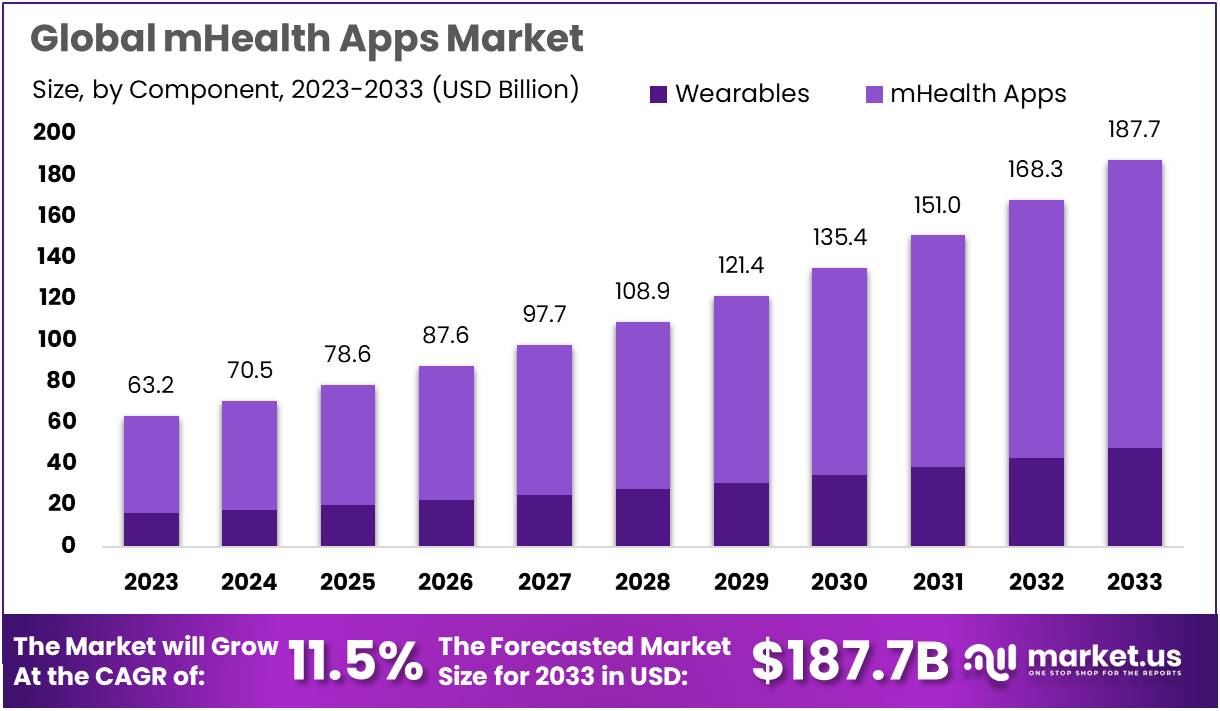
Who Downloads and Uses Health Apps?
- More than 4,000 internet-connected U.S. adults to test the adoption rates, attitudes, and preferences towards six digital health technologies.
- Overall 71% of individuals were smartphone owners.
(Source: Rock Health)
App Adoption Demographic Profiling
| Smartphone Owners | Age | Download Any App | Download Health App | Used App | Used Health App | Used App Last 30 days | Used Health Apps last 30 days |
| 32% | % age <35 | 33% | 34% | 33% | 35% | 33% | 32% |
| 36% | % age 35-55 | 36% | 36% | 36% | 35% | 35% | 36% |
| 32% | % age 55+ | 31% | 30% | 31% | 30% | 32% | 32% |
Health App Downloads: A Breakdown by Smartphone OS
- 54% of Apple/iOS users have downloaded health apps.
- 36% of Android users downloaded health apps.
- Apple users have higher active rates more than 55%.
- 47% of Android users used health apps.
Statistics on Consumers with Poor Health: Chronic Illnesses & Frequent Physician Visits
- 46% of consumers who downloaded mHealth apps have bad health or poor health status, multiple chronic illnesses, and 10+ physician office visits.
- Compared to that only 40% of those who are in good health downloaded health apps.
Reason for Downloading Health Apps Among Consumer Statistics
- 73% of consumers downloaded health apps independently.
- 22% of users downloaded health apps by family/friend recommendation.
- 16% of users downloaded health apps by recommendation of their healthcare providers.
- 7% of individuals downloaded health apps by recommendation of insurance companies.
(Source: Rock Health)
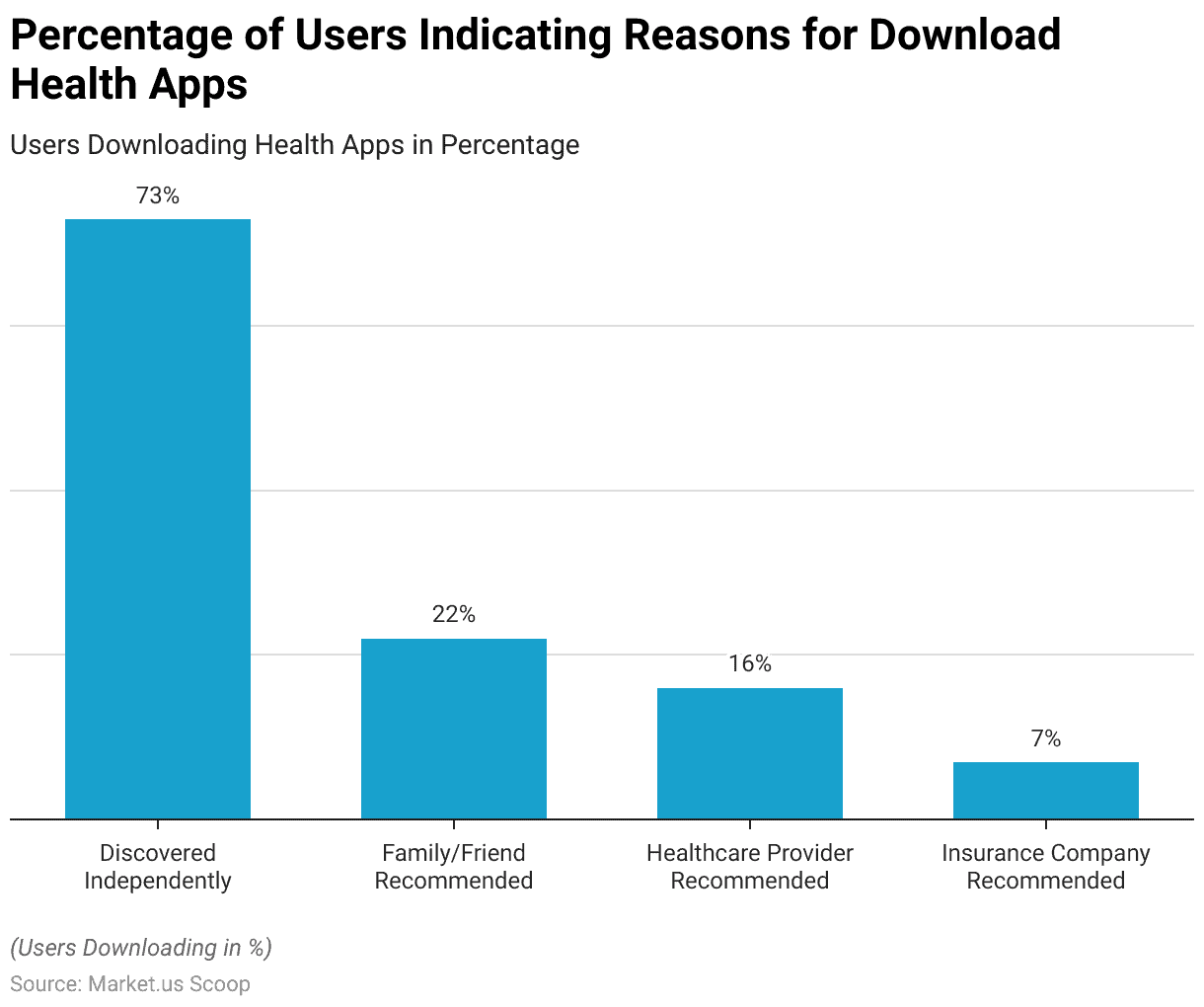
Who Uses Health Apps and Why?
Recent User’s Statistics
mHealth app technologies are emerging in the younger generation and we can notice that most of the users are dependent on mHealth apps for tracking their fitness activities and goals.
- Up to February 2022, more than 3,50,000 apps were available on different lay store platforms and they are, mostly used by older adults aged from 50-80 years.
- 3 in 10 adults reported that they are using at least one health app on their smartphone.
- 16% of adults said that they used health apps at least once in the past.
- 56% of adults reported that they haven’t used mHealth apps.
(Source: Vicert)
These mHealth apps come under the term of telemedicine technology solutions. There is a large variation regarding the use of these apps with different health goals. These apps are gaining popularity among older adults aged 50-80 years. Below are some most recent statistics on the purpose of users to use health apps.
- 34% of older adults are dependent on this technology to achieve their health goals and exercise activities.
- 22% of users downloaded health apps to get insights about nutrition.
- Due to the rising prevalence of obesity, 20% of users downloaded health apps to track their weight loss activities.
- 17% of users are dependent on health apps to track their sleep.
- 9% of users download health apps for meditation.
- 5% of people use health apps for the management of chronic mental illness or stress.
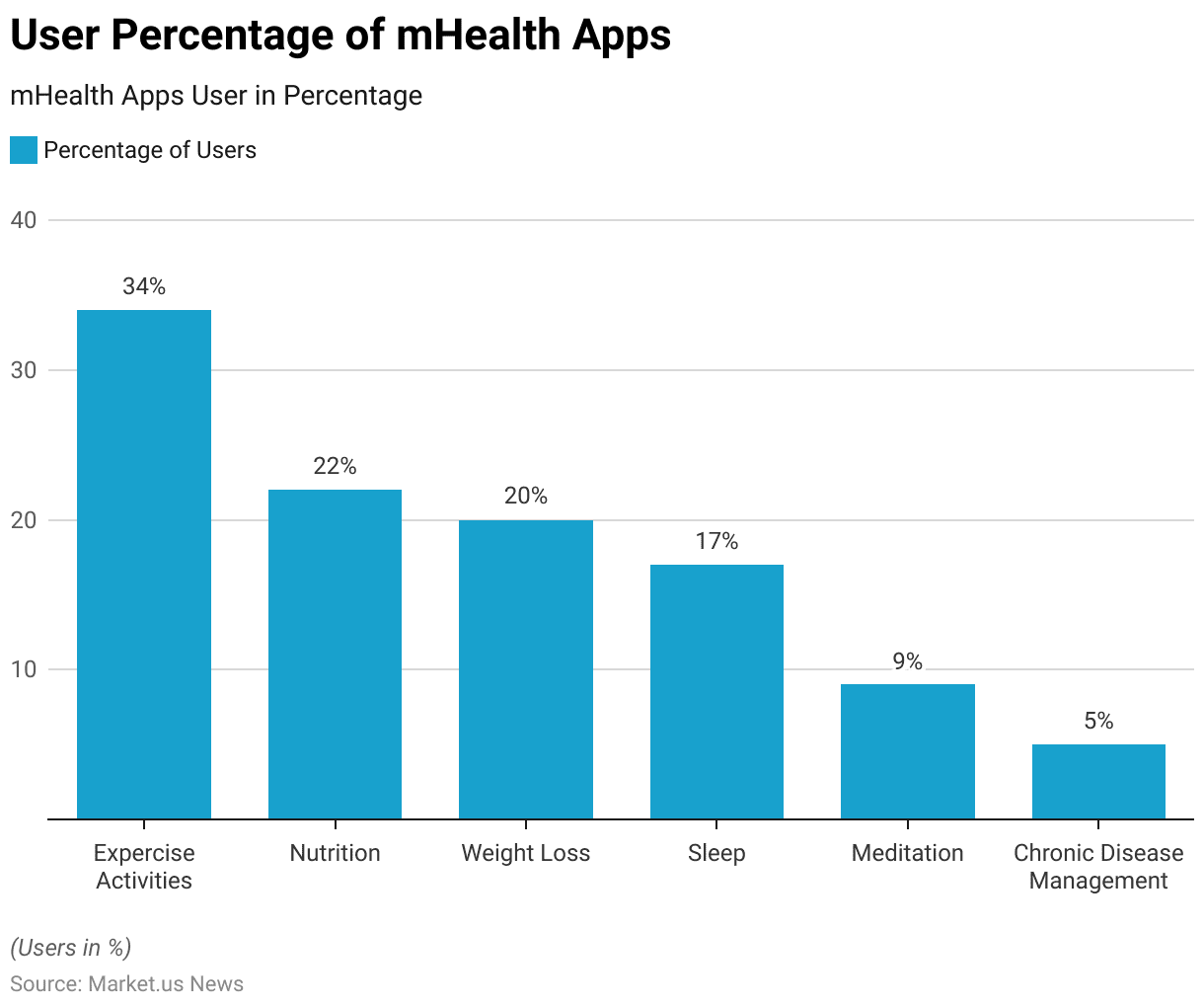
Youth Usage Statistics for mHealth Apps
- In 2022, there were approximately 6.64 billion active smartphone users globally.
- Out of these, 83% were confirmed smartphone owners.
- A significant portion (77%) of these smartphone owners were young adults, aged between 18-29 years.
- In the U.S., 84 million people made use of healthcare apps.
- Within this group, 30% heavily relied on smartphones and mHealth apps for their healthcare needs.
- Individuals under the age of 55 were found to depend more on this technology than older adults.
Young Patient Smartphone Ownership and App Download Trends
- A notable 80% of users demonstrated a high rate of smartphone ownership.
- Among adults aged 18-24 years, the smartphone ownership rate stood at 72%.
- In France, individuals within the age range of 25-39 years actively used their smartphones to download health apps.
- Within the age bracket of 40-59 years, 44% of people downloaded health apps.
- Interestingly, even in the 60-69 year age group, 20% of individuals downloaded the mhealth apps.
Top 5 mHealth Apps Statistics
mHealth apps are gaining more popularity among the older and younger generations. 85% of individuals worldwide adopted mHealth apps on their smartphones and tablets. Below are some interesting statistics on the top 5 health apps that help you achieve fitness goals.
MyFitnessPal
- It is the most popular health app that helps users to track their nutrition, exercise, and weight loss goals.
- MyFitnessPal generated USD 171 million in revenue in the year 2021, with a growth of 67% year on year.
- This app has 200 million users, making it the most popular health and fitness app.
Headspace
- This app provides guided meditation and mindfulness exercises to reduce stress and anxiety.
- Over two million people subscribe to Headspace and the app has been downloaded over 65 million times.
- Headspace generated revenue of USD 150 million in 2022.
Headspace annual subscribers (2017-2020)
- In 2017 headspace had 0.4 million subscribers.
- In 2018, this app had 1 million subscribers.
- In 2019, it had 1.3 million subscribers.
- In 2020, Headspace had 2 million subscribers.
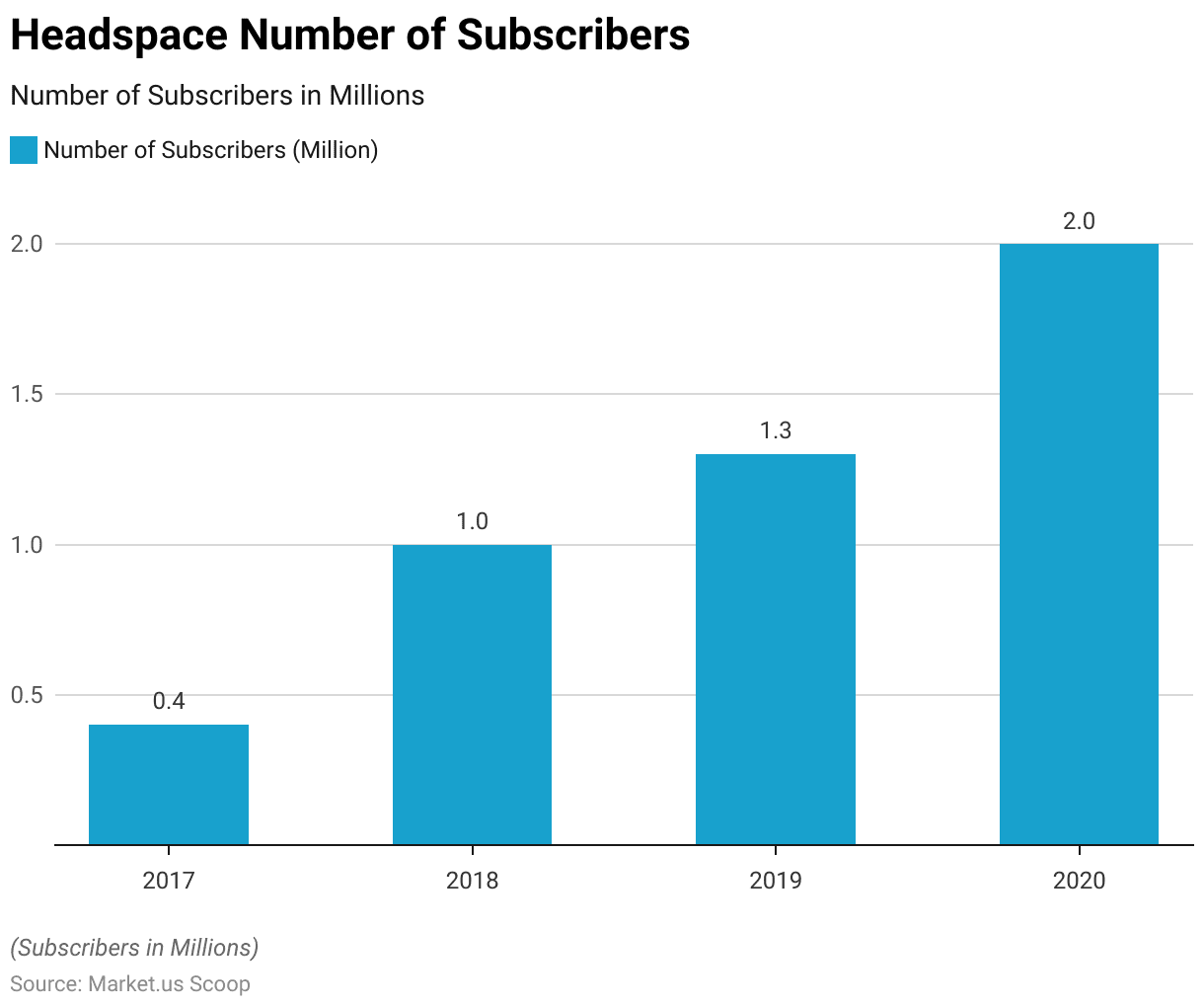
Fitbit
- Fitbit generated revenue of USD 1.21 billion in 2021, a 7% increase from the year prior.
- More than 31 million people use Fitbit once a week.
Fitbit annual revenue from 2014 to 2021 (USD Bn)
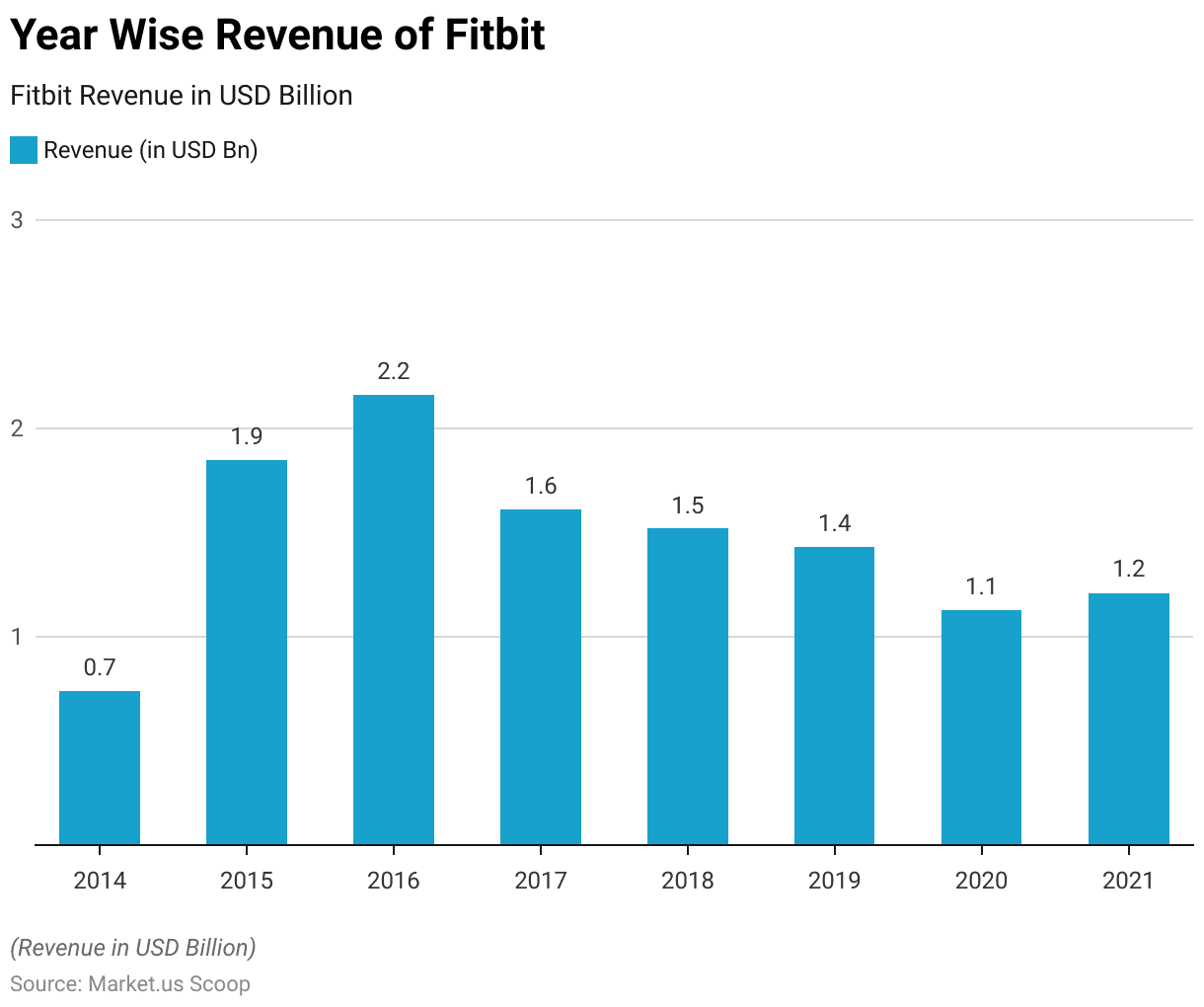
Calm
- Calm generated revenue of USD 200 million in the year 2020.
- This app has over 4 million subscribers.
- The app was valued at USD 2 billion in its latest funding round.
- More than 100 million people downloaded the Calm app.
Calm annual revenue from the year 2015-2020 (USD Mn)
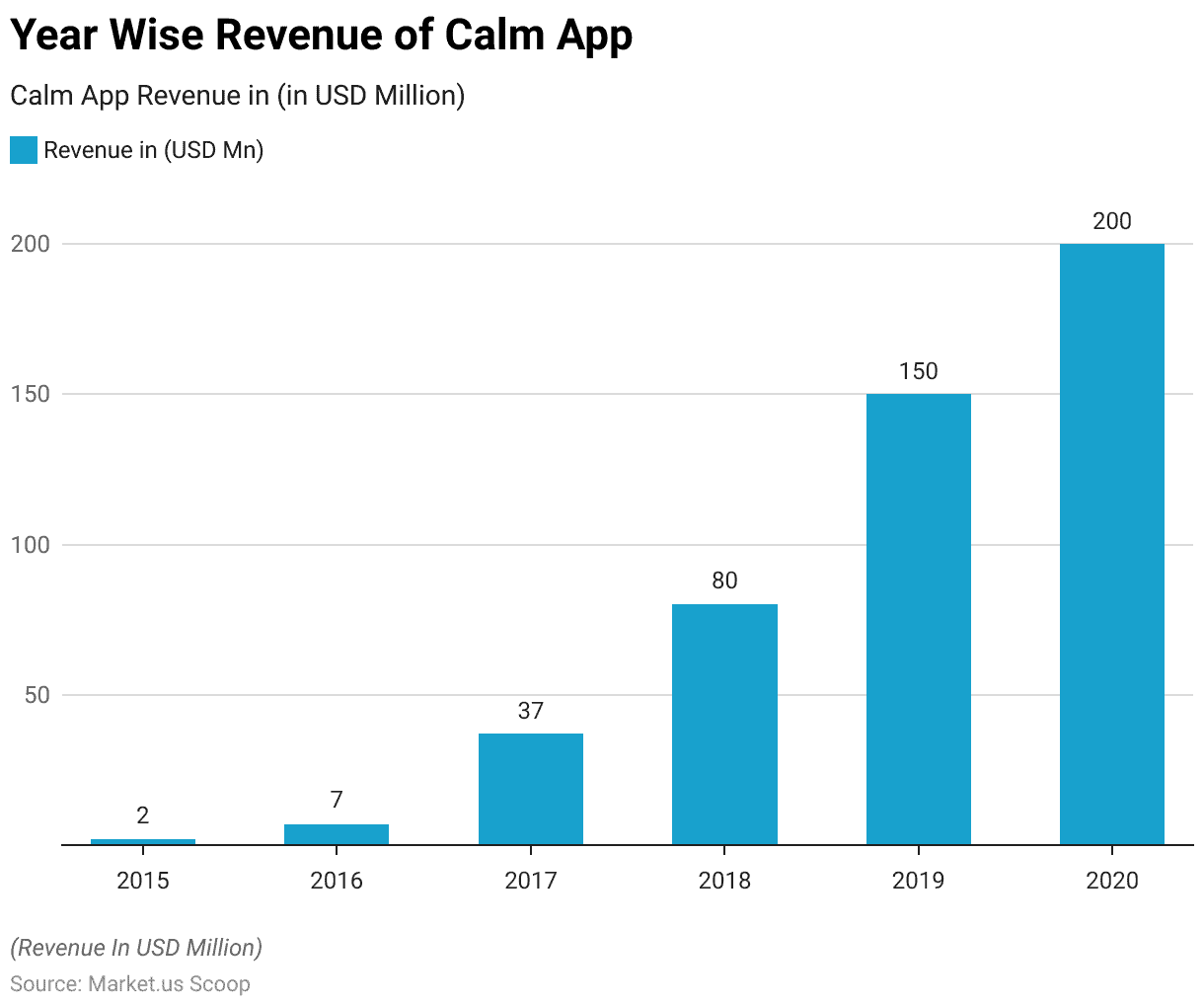
Strava
- Starva generated revenue of USD 167 million in 2021.
- Starva had 95 million active users in 2022, with addition of 2 million every month.
- More than 2 billion activities were completed on Starva in 2021.
- Starva app had 95 million users in the year 2022.
- Starva increased in popularity in 2020, especially in Europe, the Middle East, and Africa.
Starva annual revenue from the year 2017 to 2021 (USD Mn)
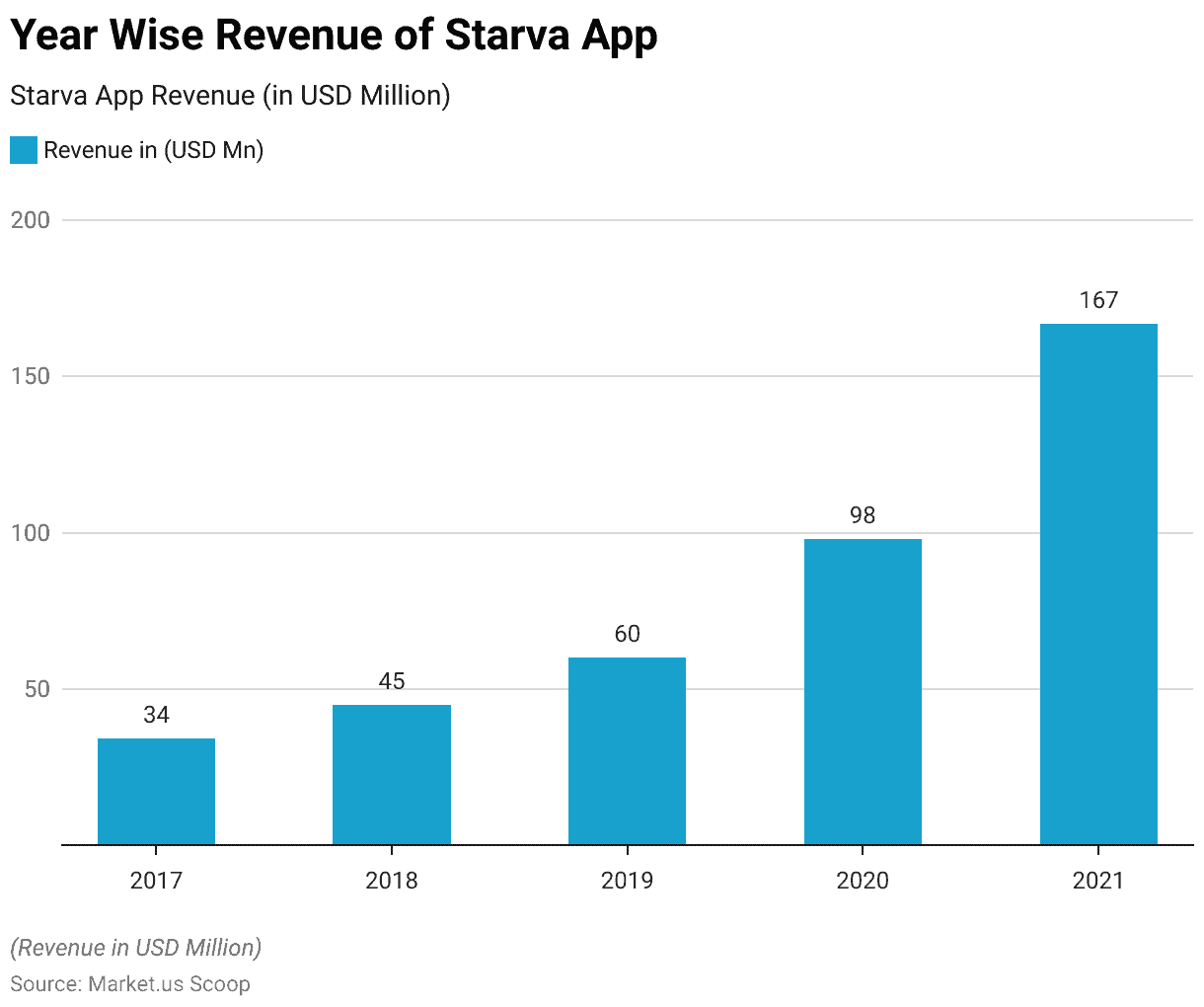
Count of mHealth Apps in the Google Play Store
Number of mHealth apps available in the Google Play Store from 1st quarter 2015 to 3rd quarter 2022 statistics
- In the most recent period, the Google Play Store featured 54,546 healthcare and medical apps, marking a slight dip from the previous quarter.
- From the start of 2020 through the end of 2021, the availability of health apps for Android users on the Google Play Store surged, exceeding 65,300 in the final quarter of 2021.
Leading iPhone health and fitness apps in Canada
- In 2022, the Impulse-Brain Training health app was downloaded by over 197,215 users in Canada.
- The AllTrails: Hike, Bike, Run app saw 23,705 downloads in the same year.
- The PC Health app was chosen by 23,439 users for download in 2022.
- The BoZone Period Tracker app experienced over 21,770 downloads by the end of 2022.
- The Sweatcoin Step Counter to Walk app was downloaded 20,600 times in 2022.
- The Paired app reached a significant milestone with over 20,135 downloads in Canada in 2022.
- The MyFitnessPal app was downloaded by 19,519 users in the year 2022.
- The Flo Period Tracker & Calendar app recorded over 19,401 downloads in the year 2022.
- The Motivation-Daily quotes app was selected for download by 19,213 users in 2022.
- Finally, the Yuka-Food & Cosmetic scanner app saw more than 16,435 downloads in Canada in 2022.
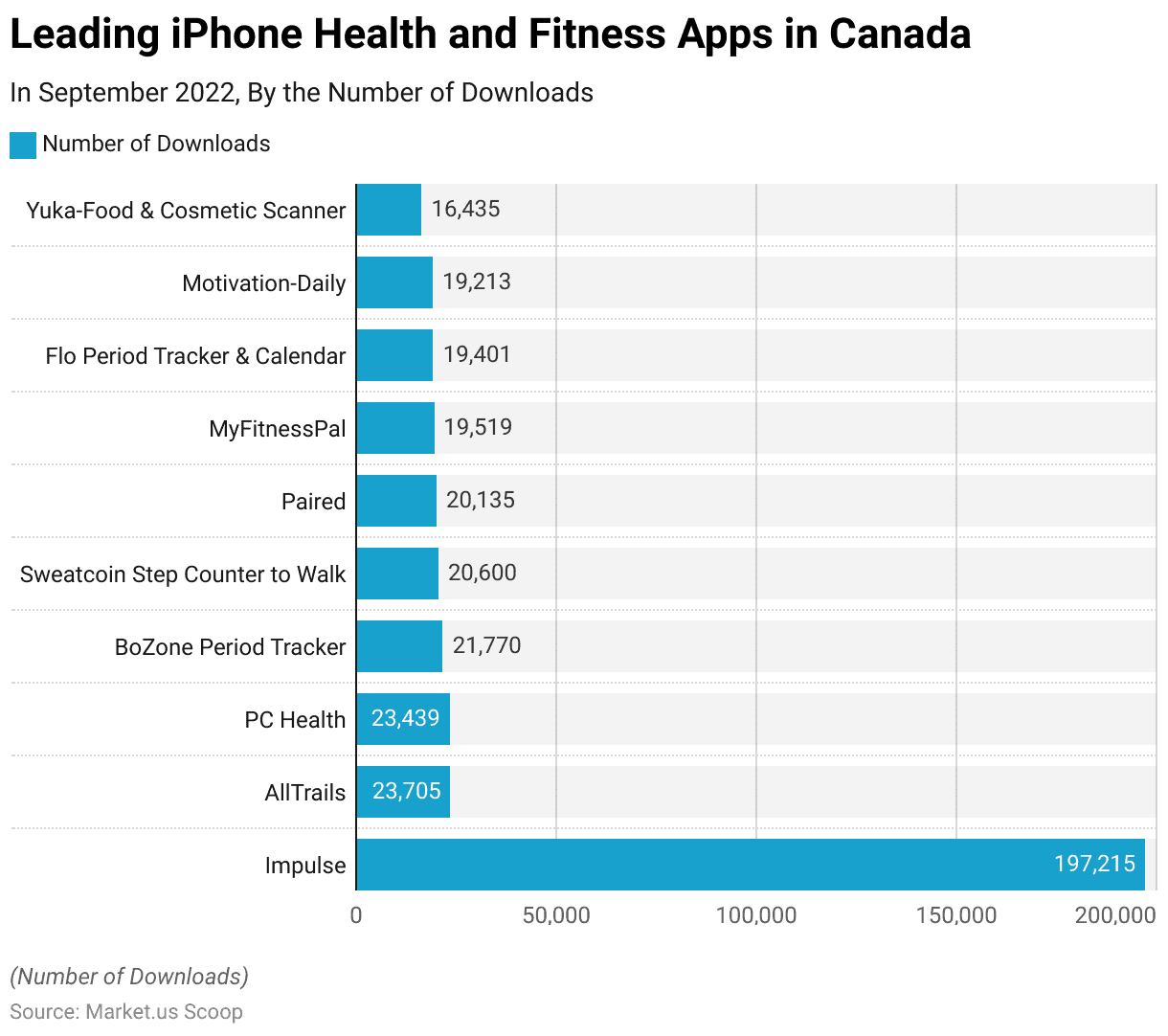
mHealth Market Revenue of Latin America Statistics
- In 2022, the mHealth market in Latin America accounted for revenue of 4.82 billion.
- The market revenue is expected to reach 6.58 billion at the end of year 2023.
- The market is expected to reach a revenue of 22.78 billion in 2027.
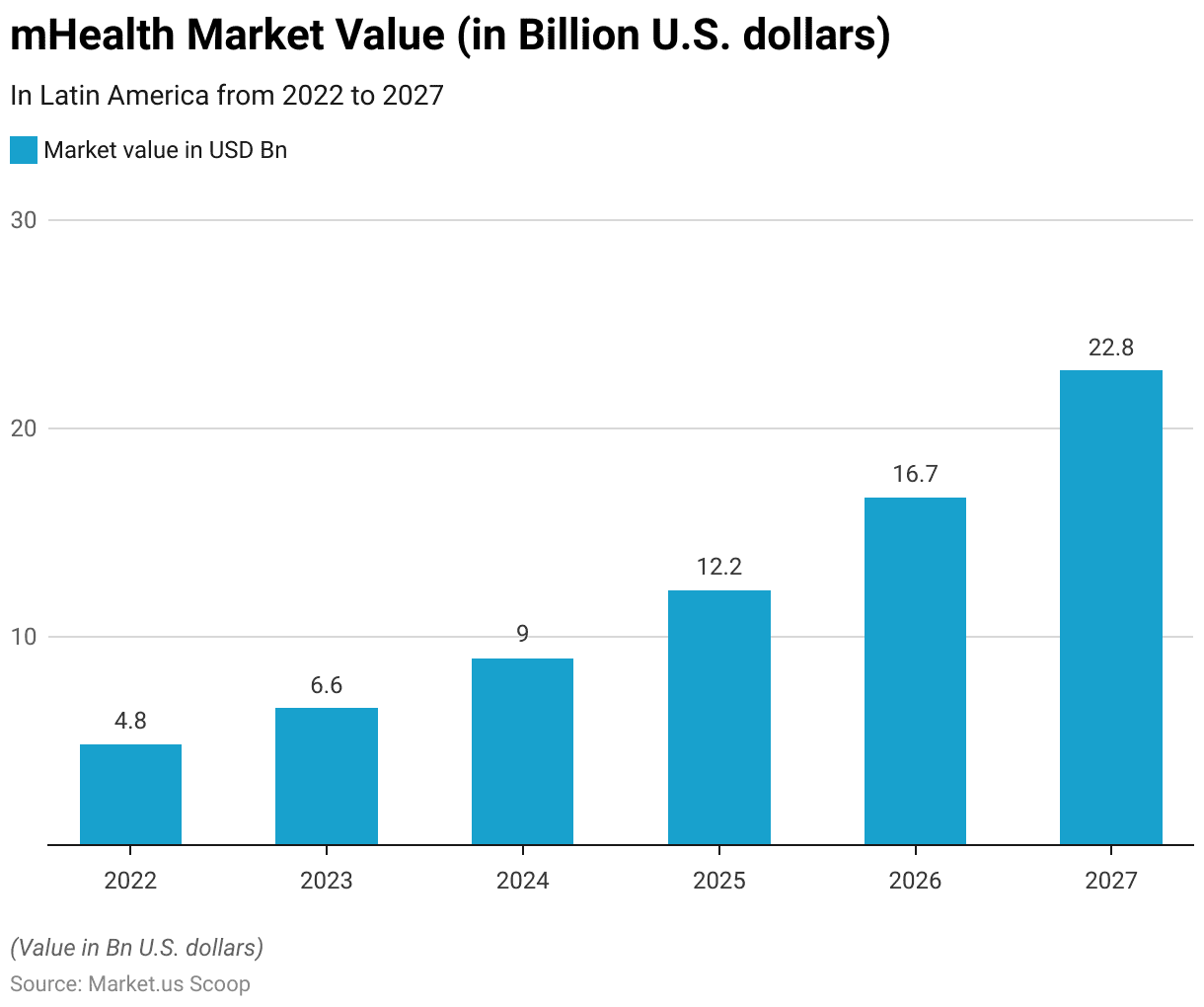
COVID-19 and the mHealth apps Revolution Statistics
The COVID-19 pandemic has had a significant impact on the use and development of mHealth apps. Due to the increased spreading of coronavirus, people have become health conscious and looking for a way to monitor and manage their health remotely.
This has led to the demand for mHealth apps. Telemedicine apps have become more popular during the pandemic, allowing patients to consult with their healthcare providers.
COVID-19 and Telemedicine Use: A Statistical Snapshot
- 58% of surveyed physicians in 2021 view telehealth more favorably.
- In January 2019, 82% of individuals preferred video visits.
- 69% of individuals rated their virtual visit a 9 out of 10.
- In July 2019 found that 81% of respondents preferred a provider who offered telemedicine services.
- Usage of telehealth has doubled from 14% in 2016 to 28% in 2019.
- In the last five years, telemedicine has grown by 44%.
- 66% of consumers are eager to use telehealth, and 8% have tried it in 2019.
- Only 20% of consumers willing to use telehealth said they would use it to see a pediatrician for their child.
China’s mHealth Apps: Pre and Post-COVID-19 Usage Statistics
- Before the COVID-19 pandemic, there were 1.44 million app downloads, which significantly increased to 2.74 million during the pandemic.
- Post-pandemic, out of the top 10 mHealth app features, four were related to maternal and child health.
- Pregnancy preparations ranked second, women’s health was fifth, and pregnancy-related apps stood at the sixth position.
- During the pandemic, 11.4% of mHealth apps introduced functions or content specifically related to COVID-19.
- The usage of mHealth apps was widespread, with 57.8% of healthy individuals using these apps.
- Among those with any disorder, 32.2% relied on mHealth apps during the COVID-19 pandemic.
- Lastly, 24.7% of healthcare professionals utilized mHealth apps during the COVID-19 outbreak.
mHealth app Statistics: Challenges Unveiled
- 63% of the challenges are due to not having enough rules and guidelines to make sure mHealth apps are safe.
- 56% of the challenges come from not knowing enough about technology.
- 19% of the challenges are because the people who should be involved in making the mHealth app aren’t.
- 13% of the challenges come from not having enough resources to make secure mHealth apps.
- 42% of people around the world don’t know how to use mHealth apps.
- 50% of doctors don’t want to buy mHealth apps because they’re worried about the privacy and security of their patients.
- 91% of mHealth apps don’t pass tests that check if they’re safe.
- 71% of all apps have at least one major security problem.
- 28% of apps on iPhones can have their encryption key (which keeps data safe) stolen.
- 34% of apps on Android phones can have their encryption broken.
- 83% of major threats can be stopped by using protection within the app itself.
Recent Developments
Acquisitions and Mergers:
- HealthTech Enterprises acquired WellnessApps Inc. for $90 million, consolidating their mHealth app portfolios and expanding their market presence in the digital health sector.
- MobileMed Solutions merged with CareTech Innovations, forming a synergistic partnership to offer integrated mHealth solutions, with combined annual revenues projected to surpass $300 million.
New Product Launches:
- FitHealth unveiled a fitness tracking app with personalized workout plans and nutrition tracking features, targeting a user base of 5 million within the first year of launch.
- MedConnect introduced a medication management app with pill reminders and dosage tracking functionalities, aiming to reach 3 million downloads within the next six months.
Funding Rounds:
- HealthApp received $40 million in Series B funding led by Venture Capital Firm XYZ to enhance their mHealth platform’s features and expand into new markets, to double user engagement metrics within two years.
- CareLink secured $20 million in seed funding from Angel Investors Group ABC to scale up user acquisition efforts and invest in AI-powered predictive analytics for personalized health recommendations, targeting a 50% increase in monthly active users.
Consumer Trends:
- Rising adoption of wearables and connected devices spurred the demand for mHealth apps, with downloads increasing by 35% compared to the previous year.
- Mental health and mindfulness apps experienced significant growth, with meditation and stress-relief apps witnessing a 40% increase in user engagement, reflecting growing awareness of mental well-being.
Regulatory Landscape:
- Regulatory bodies implemented guidelines to ensure data privacy and security in mHealth apps, fostering consumer trust and confidence in digital health solutions, while maintaining compliance with healthcare regulations.
Conclusion
mHealth Apps Statistics: Mobile Health (mHealth apps) have the potential to transform healthcare delivery by providing convenient and cost-effective healthcare services.
The COVID-19 pandemic has surged the adoption of mHealth apps, creating new market opportunities for developers and investors in this field.
There are several challenges that developers and users face such as data privacy, security, and maintaining data accuracy.
Due to this challenge, mHealth apps becoming more popular and their potential benefits are increasing. With continued innovations and improvements in mHealth apps, it is expected that they will play an important role in healthcare delivery in the future.
FAQs
mHealth apps are applications that are designed for mobile devices, such as smartphones and tablets, that help in providing healthcare-related services and information. These apps are aimed to provide individuals with health and wellness information. Below are some common features of mHealth apps.
mHealth apps can provide several benefits, such as remote monitoring of health conditions, access to healthcare services and information, improved medication adherence, and promotion of healthy behaviors.
mHealth Apps have become an important part of our daily life. Smartphones, laptops, or other technological devices are not without apps. In healthcare, apps have become a standard solution to several problems and issues in the healthcare industry. Health apps can be accessed anytime and anywhere, making it easy for people to monitor their health and stay at peak in their fitness goals.
Discuss your needs with our analyst
Please share your requirements with more details so our analyst can check if they can solve your problem(s)



